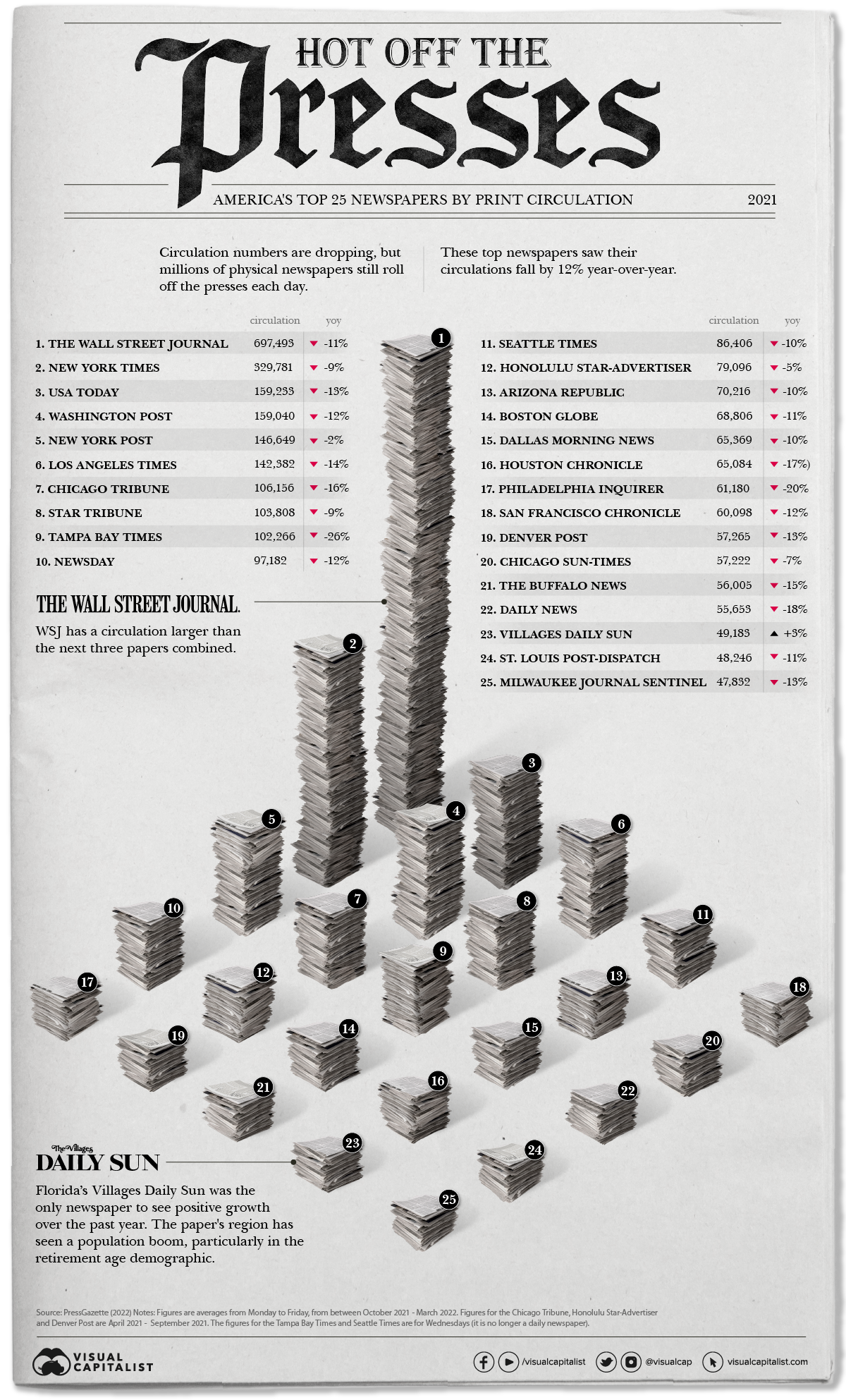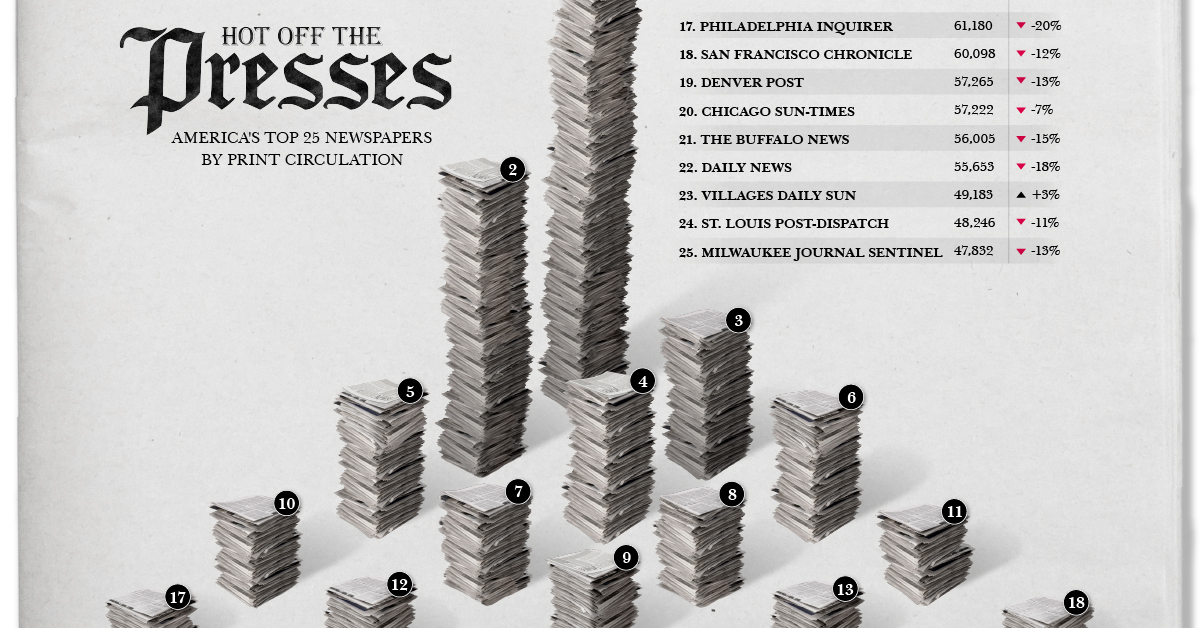Business
Visualized: The Top 25 U.S. Newspapers by Daily Circulation

Visualized: The Top 25 U.S. Newspapers by Daily Circulation
Most people today—more than 8 in 10 Americans—get their news via digital devices, doing their reading on apps, listening to podcasts, or scrolling through social media feeds.
It’s no surprise then that over the last year, only one U.S. newspaper of the top 25 most popular in the country saw positive growth in their daily print circulations.
Based on data from Press Gazette, this visual stacks up the amount of daily newspapers different U.S. publications dole out and how that’s changed year-over-year.
Extra, Extra – Read All About It
The most widely circulated physical newspaper is the Wall Street Journal (WSJ) by a long shot—sending out almost 700,000 copies a day. But it is important to note that this number is an 11% decrease since 2021.
Here’s a closer look at the data.
| Rank | Newspaper | Average Daily Print Circulation | Year-Over-Year Change |
|---|---|---|---|
| #1 | Wall Street Journal | 697,493 | −11% |
| #2 | New York Times | 329,781 | −9% |
| #3 | USA Today | 159,233 | −13% |
| #4 | Washington Post | 159,040 | −12% |
| #5 | New York Post | 146,649 | −2% |
| #6 | Los Angeles Times | 142,382 | −14% |
| #7 | Chicago Tribune | 106,156 | −16% |
| #8 | Star Tribune | 103,808 | −9% |
| #9 | Tampa Bay Times | 102,266 | −26% |
| #10 | Newsday | 97,182 | −12% |
| #11 | Seattle Times | 86,406 | −10% |
| #12 | Honolulu Star-Advertiser | 79,096 | −5% |
| #13 | Arizona Republic | 70,216 | −10% |
| #14 | Boston Globe | 68,806 | −11% |
| #15 | Dallas Morning News | 65,369 | −10% |
| #16 | Houston Chronicle | 65,084 | −17% |
| #17 | Philadelphia Inquirer | 61,180 | −20% |
| #18 | San Francisco Chronicle | 60,098 | −12% |
| #19 | Denver Post | 57,265 | −13% |
| #20 | Chicago Sun-Times | 57,222 | −7% |
| #21 | The Buffalo News | 56,005 | −15% |
| #22 | Daily News | 55,653 | −18% |
| #23 | Villages Daily Sun | 49,183 | 3% |
| #24 | St. Louis Post-Dispatch | 48,246 | −11% |
| #25 | Milwaukee Journal Sentinel | 47,832 | −13% |
These papers, although experiencing negative growth when it comes to print, are still extremely popular and widely-read publications digitally—not only in the U.S., but worldwide. For example, the New York Times reported having reached 9 million subscribers globally earlier this year.
The one paper with increased print circulation was The Villages Daily Sun, which operates out of a retirement community in Florida. Elderly people tend to be the most avid readers of print papers. Another Florida newspaper, the Tampa Bay Times, was the worst performer at -26%.
In total, 2,500 U.S. newspapers have shut down since 2005. One-third of American newspapers are expected to be shuttered by 2025. This particularly impacts small communities and leaves many across America in ‘news deserts.’
Print vs. Digital Newspapers
Regardless of print’s downturn, digital subscriptions remain much higher for most of these papers. As one example, The Washington Post has over 3 million online subscribers, compared to their 159,000 print readers.
To put things in perspective, around 24 million print papers now circulate throughout the U.S. on any given day. But looking back at the industry’s peak in the 1980s, almost 64 million were distributed on any given weekday.
And digital is not done growing. Newsroom hires have been ramping up for “digital-native” news sites—publications that started online and never had a print version. On the flipside, employment at traditional papers has more than halved since 2008.
Problems with Media
American news media can be extremely divisive. Many newsrooms across the country play into fear, sensationalism, and partisan politics.
Digital news only makes this worse, utilizing algorithms designed to keep a person’s eyes on the page longer, pushing stories with narratives a person shows interest in, and often taking them down a rabbit hole of fringe information—sometimes towards the extremes.
Additionally, the business of journalism is an increasingly less lucrative industry. Most revenue comes from digital ads running on news sites—so rather than selling the news to consumers, it’s the time and attention of consumers that is being sold to advertisers. Furthermore, some of the best quality content is locked up behind subscription-based paywalls.
Print may actually be one way to avoid some of the more obvious issues, particularly because there’s no way to track the data on which stories you read. But all publications still have inherent bias, of course, and it’s clear that print papers are not bouncing back any time soon.
Brands
How Tech Logos Have Evolved Over Time
From complete overhauls to more subtle tweaks, these tech logos have had quite a journey. Featuring: Google, Apple, and more.

How Tech Logos Have Evolved Over Time
This was originally posted on our Voronoi app. Download the app for free on iOS or Android and discover incredible data-driven charts from a variety of trusted sources.
One would be hard-pressed to find a company that has never changed its logo. Granted, some brands—like Rolex, IBM, and Coca-Cola—tend to just have more minimalistic updates. But other companies undergo an entire identity change, thus necessitating a full overhaul.
In this graphic, we visualized the evolution of prominent tech companies’ logos over time. All of these brands ranked highly in a Q1 2024 YouGov study of America’s most famous tech brands. The logo changes are sourced from 1000logos.net.
How Many Times Has Google Changed Its Logo?
Google and Facebook share a 98% fame rating according to YouGov. But while Facebook’s rise was captured in The Social Network (2010), Google’s history tends to be a little less lionized in popular culture.
For example, Google was initially called “Backrub” because it analyzed “back links” to understand how important a website was. Since its founding, Google has undergone eight logo changes, finally settling on its current one in 2015.
| Company | Number of Logo Changes |
|---|---|
| 8 | |
| HP | 8 |
| Amazon | 6 |
| Microsoft | 6 |
| Samsung | 6 |
| Apple | 5* |
Note: *Includes color changes. Source: 1000Logos.net
Another fun origin story is Microsoft, which started off as Traf-O-Data, a traffic counter reading company that generated reports for traffic engineers. By 1975, the company was renamed. But it wasn’t until 2012 that Microsoft put the iconic Windows logo—still the most popular desktop operating system—alongside its name.
And then there’s Samsung, which started as a grocery trading store in 1938. Its pivot to electronics started in the 1970s with black and white television sets. For 55 years, the company kept some form of stars from its first logo, until 1993, when the iconic encircled blue Samsung logo debuted.
Finally, Apple’s first logo in 1976 featured Isaac Newton reading under a tree—moments before an apple fell on his head. Two years later, the iconic bitten apple logo would be designed at Steve Jobs’ behest, and it would take another two decades for it to go monochrome.
-

 Markets1 week ago
Markets1 week agoRanked: The Largest U.S. Corporations by Number of Employees
-

 Green3 weeks ago
Green3 weeks agoRanked: Top Countries by Total Forest Loss Since 2001
-

 Money2 weeks ago
Money2 weeks agoWhere Does One U.S. Tax Dollar Go?
-

 Automotive2 weeks ago
Automotive2 weeks agoAlmost Every EV Stock is Down After Q1 2024
-

 AI2 weeks ago
AI2 weeks agoThe Stock Performance of U.S. Chipmakers So Far in 2024
-

 Markets2 weeks ago
Markets2 weeks agoCharted: Big Four Market Share by S&P 500 Audits
-

 Real Estate2 weeks ago
Real Estate2 weeks agoRanked: The Most Valuable Housing Markets in America
-

 Money2 weeks ago
Money2 weeks agoWhich States Have the Highest Minimum Wage in America?


















